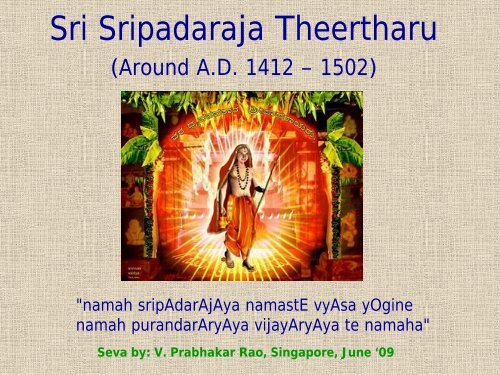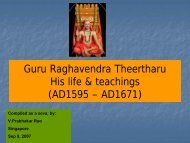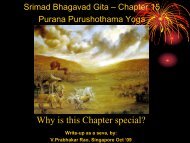Sri Sripadaraja Theertharu
Sri Sripadaraja Theertharu
Sri Sripadaraja Theertharu
Create successful ePaper yourself
Turn your PDF publications into a flip-book with our unique Google optimized e-Paper software.
<strong>Sri</strong> <strong>Sri</strong>padaraja <strong>Theertharu</strong><br />
(Around A.D. 1412 – 1502)<br />
"namah sripAdarAjAya namastE vyAsa yOgine<br />
namah purandarAryAya vijayAryAya te namaha"<br />
Seva by: V. Prabhakar Rao, Singapore, June ‘09
<strong>Sri</strong> Gurubyo Namaha<br />
It is my humble intention to write about the life and works<br />
of <strong>Sri</strong> <strong>Sri</strong>padarajaru, as the aradhana of this Yathiraja is<br />
around the corner (June 6 th ). I seek the blessings of my<br />
Guru <strong>Sri</strong> Raghavendra Rayaru in this endeavour.
<strong>Sri</strong> <strong>Sri</strong>padaraja <strong>Theertharu</strong><br />
<strong>Sri</strong> <strong>Sri</strong>padarajaru was one of the outstanding Yathis<br />
of the Madhwa Parampara. It is believed that he is<br />
the incarnation of Dhruva. His contributions to the<br />
spread of madhva siddhantha and to haridAsa<br />
sAhitya are considerable. He was also the<br />
vidyAguru of <strong>Sri</strong> Vyasaraja <strong>Theertharu</strong>.<br />
<strong>Sri</strong> <strong>Sri</strong>padarajaru is considered to be the originator<br />
of Dasakuta. That is why his name stands first in<br />
the following stotra which is sung at the beginning<br />
of any traditional Harikatha discourse<br />
"namah sripAdarAjAya namastE vyAsa yOgine<br />
namah purandarAryAya vijayAryAya te namaha"<br />
He is also referred to as ‘Dasa Pitamaha'<br />
(Grandfather of Dasas). He spread the message of<br />
Bhagavatha Dharma through his devarunamas.<br />
<strong>Sri</strong> <strong>Sri</strong>padaraja <strong>Theertharu</strong> Brindavana
<strong>Sri</strong> Lakshmi Narayana – Early Days<br />
Born in Abbur, a picturesque village about<br />
60 kms from Bangalore, to a poor couple<br />
Abbur <strong>Sri</strong> Seshagiri Achar and Smt<br />
Giriamma, the young boy Lakshmi<br />
Narayana was to become the highly<br />
revered <strong>Sri</strong> <strong>Sri</strong>padarajaru later on in his<br />
life.<br />
He had his aksharabyasa from his father.<br />
As a boy he was used to taking care of<br />
cattle herd during the daytime to help his<br />
family. Even at that young age he had a<br />
dignified appearance and leadership<br />
qualities. He will organise and stage<br />
Dasavathara plays, along with his friends,<br />
and invariably he will play the main<br />
character in these plays.
<strong>Sri</strong> Lakshmi Narayana - Destiny<br />
<strong>Sri</strong> Swarnavarna <strong>Theertharu</strong> was on his way to<br />
Abbur. The young Lakshminarayana was taking<br />
care of his herd. <strong>Sri</strong> Swarnavarna theertharu,<br />
anxious to know the distance of the village, made<br />
an enquiry with the boy. Lakshminarayana<br />
answered the question intelligently by saying "see<br />
me, see my herd, gaze at the sky and realize the<br />
distance" and stood calmly. Swamiji was<br />
wonderstruck at his intelligence and was pleased<br />
with his presence of mind. He asked him to lead<br />
him to the ashram of <strong>Sri</strong> Purushoththama<br />
<strong>Theertharu</strong>. There the Swamiji was also highly<br />
impressed with <strong>Sri</strong> Brahmanya Theertha, the<br />
disciple of <strong>Sri</strong> Purushoththama <strong>Theertharu</strong>. After<br />
conferring with <strong>Sri</strong> Purushoththama <strong>Theertharu</strong>,<br />
<strong>Sri</strong> Swarnavarna <strong>Theertharu</strong> decided to take the<br />
young Lakshminarayana under his wings.
<strong>Sri</strong> Lakshmi Narayana Yogi<br />
Very soon the young man Lakshmi Narayana became a very scholarly pandit. Impressed by the prowess of<br />
his sishya, <strong>Sri</strong> Swarnavarna <strong>Theertharu</strong>, in his old age, decided to make him his successor. After taking<br />
the consent of his parents, he gave him sanyasa and named him <strong>Sri</strong> Lakshmi Narayana Yogi. For<br />
sometime <strong>Sri</strong> Swarnavarna theertharu was with <strong>Sri</strong> Lakshmi Narayana, as he was engaged in<br />
pravachana, japa tapa, guruseva .... Reposing full confidence in his shishya, Swarnavarna muni handed<br />
over to him his samsthana with all its grandeur and entered the brindavana there at <strong>Sri</strong>rangam. Thus <strong>Sri</strong><br />
Lakshmi Narayana Yogi occupied the peeta.<br />
Brindavana of <strong>Sri</strong> Swarnavarna <strong>Theertharu</strong> at <strong>Sri</strong>rangam
<strong>Sri</strong> <strong>Sri</strong>padarajaru – How come the name?<br />
Once he occupied the peeta, his lustre grew manyfold. He went<br />
on theerthayatra with <strong>Sri</strong> Vibhudendra <strong>Theertharu</strong> (the purva<br />
peetathipathi of <strong>Sri</strong> Rayaru Mutt) and <strong>Sri</strong> Raghunatha<br />
<strong>Theertharu</strong> of Uttaradi Mutt. <strong>Sri</strong> Raghunatha <strong>Theertharu</strong> was<br />
far senior to <strong>Sri</strong> Lakshmi Narayana Yogi and a highly respected<br />
yathi in the madhwa parampara. <strong>Sri</strong> Lakshmi Narayana Yogi<br />
showed all due respects to him. <strong>Sri</strong> Raghunatha <strong>Theertharu</strong><br />
wanted to test his pandithya. <strong>Sri</strong> Lakshmi Narayana impressed<br />
him hugely with a flowing commentary on a difficult phrase<br />
from the famous grantha “Nyayasudha”.<br />
The extremely happy <strong>Sri</strong> Raghunatha <strong>Theertharu</strong> said “If we are<br />
all <strong>Sri</strong>padarus (sanyasis) you are truly <strong>Sri</strong>padaraja (King of<br />
Sanyasis)”. And he blessed him that he will be as famous as<br />
<strong>Sri</strong>mad Acharya and <strong>Sri</strong> Teekacharya.<br />
Since then <strong>Sri</strong> Lakshmi Narayana Yogi became known as<br />
<strong>Sri</strong> <strong>Sri</strong>padarajaru
<strong>Sri</strong>padaraja Mutt<br />
Sometime after he became the Pontiff of the Mutt, he set out on travel. He came to<br />
Mulubagilu and made up his mind to stay there knowing well its Historical, Educational and<br />
Dharmic background. At that time Mulubagilu was under the control of Vijayanagar kings.<br />
<strong>Sri</strong>padarajaru comes in the divine parampara of Padmanabhatheertha Mutt. <strong>Sri</strong> Padamanabha<br />
theertharu was the direct disciple of Shri Madhwacharya. He was the first to write notes<br />
(Sanyayarathnavali & sattarkadeepavali) on Madhwacharya's great works. He paved the way<br />
for dwaitha sidhanta to scale new heights. Narayana pandithacharya has lot of praise for <strong>Sri</strong><br />
Padmanabha theertharu as a lion critic . <strong>Sri</strong> Jayatheertharu has described him as a pure person<br />
who lived in the ocean of chaste knowledge.<br />
<strong>Sri</strong> Padmanabha muni saw to it that his monastic order remained wedded to propagation of<br />
dharma. This mutt was called as Padmanabhatheertha mutt before <strong>Sri</strong>padarajaru, and after<br />
him, because of the alluring personality of <strong>Sri</strong>padarajaru it became famous as <strong>Sri</strong>padarja mutt.<br />
Ref: www.sripadarajamutt.org
<strong>Sri</strong> Ranga Vittala<br />
Having spent considerable time at <strong>Sri</strong>rangam, <strong>Sri</strong> <strong>Sri</strong>padarajaru observed the tradition at <strong>Sri</strong>rangam temple<br />
and recognised the divine power of music to carry bhakthi and dharma to common people. Furthermore he<br />
was conscious of the fact that if the lines are kept simple and in the native language, they can be understood<br />
by even simple folks. With these inspirations he started composing many devarunamas in kannada and<br />
started the tradition of singing them during the puja. On the banks of Bhimarathi nadhi, as indicated in his<br />
dream, he found buried a golden box which contained the lovely vigraha of <strong>Sri</strong> Ranga Vittala. It became his<br />
ankitha (signature) in his devarunamas.<br />
His Bhramaragita, Venugita, Gopigita are said to be beautiful and full of the essence of<br />
<strong>Sri</strong>mad Bhagavatham<br />
Ref: <strong>Sri</strong> Haridasa Vijayam compiled by Smt Padma <strong>Sri</strong>nivasan
“Mahime Saladhe”<br />
In A.D. 1471, King Chaluva Narasimhan of Chandragiri took refuge under <strong>Sri</strong> <strong>Sri</strong>padarajaru<br />
to get rid of the dosha due to his wrong deeds. <strong>Sri</strong> <strong>Sri</strong>padarajaru saved him through his tapas<br />
sakthi. In gratitude he seated him on his simhasana and conducted kanakabishekha. On that<br />
occasion his sishya <strong>Sri</strong> Vyasaraja <strong>Theertharu</strong> composed and sang the famous devarunama<br />
“Mahime Saladhe”.<br />
The king of Vijayanagara continuously requested <strong>Sri</strong>padaraja to settle down in his kingdom, and become<br />
his Raja-Guru. <strong>Sri</strong>padaraja declined to do so due to old age, but agreed to send his beloved disciple Shri<br />
Vyasaraja instead. Thus Shri Vyasaraja became the Raja-Guru of the Vijayanagara empire.
<strong>Sri</strong> Madhvanama<br />
“<strong>Sri</strong> Madhvanama” is a legendary composition of <strong>Sri</strong> <strong>Sri</strong>padarajaru, which extols<br />
the greatness of Hanuma, Bhima, Madhva “avatharatraya”. The phalastuthi of<br />
this great work was written by <strong>Sri</strong> Jagannatha Dasaru three hundred years later.<br />
“jaya jaya jagatrANa, jagadoLage sutrANa<br />
akhila guNa sadhdhAma madhvanAma”
<strong>Sri</strong> <strong>Sri</strong>padarajaru’s Devarunamas<br />
"Ne ittahange iruvEno hariye ...", "Kangalidyathako kAveri rangana nOdada..", "BhUshanake<br />
BhUshana ...“ are some of the most inspiring devarunamas of <strong>Sri</strong> <strong>Sri</strong>padarajaru. Of these,<br />
“Bhushanake Bhushana” has a tremendous personal impact on me. Everytime I listen to it, it<br />
never fails to lift me up.
“Nyayasudhopanyasa – Vagvajra”<br />
This is a literary work ascribed to <strong>Sri</strong> <strong>Sri</strong>padarajaru. It is a<br />
commentary on <strong>Sri</strong>man Nyayasudha. It is a lucid and attractive<br />
commentary in 3500 slokas. The exposition is exhaustive and the<br />
style graceful.<br />
Ref: “History of the Dvaita school of vedanta and its literature”<br />
by Dr. B.N.K.Sharma
<strong>Sri</strong> <strong>Sri</strong>padarajaru’s Brindavana<br />
Narasimha Theertha<br />
<strong>Sri</strong> <strong>Sri</strong>padarajaru has his brindavana at a place called<br />
Narasimha Theertha, about a mile from Mulabagilu, on the<br />
Bangalore and Madras national highway. There is an<br />
interesting anecdote about Narasimha Theertha which goes<br />
as follows: It is said that when he was in his old age, he<br />
wanted to have Ganga-snana, but could not travel all the<br />
way up north. Ganga then appeared before him and said<br />
that she herself would come to Narasimha Theertha and<br />
stay there for ever. From then on, a dip in Narasimha<br />
Theertha is considered to be equivalent to a dip in Ganga.<br />
The following stotra in honor of <strong>Sri</strong> <strong>Sri</strong>padarajaru was<br />
composed by <strong>Sri</strong> Vyasarayaru:<br />
Tham vande narasimha theertha nilayam <strong>Sri</strong> vyasaraja poojitham<br />
Dhayantham manasa nrusimha charanam SrIpadarajaram gurum.<br />
Pada Vakya Pramatabhyam Vikreedana Visharadam<br />
LakshmiNarayana Muneem Vande Vidya Gurunmama.
<strong>Sri</strong> Yoga Narasimha<br />
At Narasimha theertha near Mulubagilu, <strong>Sri</strong> Akshobhya theertharu,<br />
using angaara sketched Lord Narasimha and later on the murthy was<br />
formed on its own.
BrahmanyaPura Mukhyapranadevaru Temple<br />
It is said that <strong>Sri</strong> Brahmanya Teertharu, <strong>Sri</strong> Vyasarayaru and <strong>Sri</strong> <strong>Sri</strong>padarajaru installed this<br />
moorthy. The idol of Pranadevaru represents the three avatara of Mukhyapranadevaru viz.,<br />
Hanuma, Bhima and Madhwa. The “Shika” of the pranadevaru represents the Madhwa avatara.<br />
The Saugandhika pushpa in hand represents the Bhimavathara. It’s a very beautiful murthi.<br />
Ref: Jignaasa – Madhwa Youth Forum – Web page
<strong>Sri</strong> Brahmanya <strong>Theertharu</strong><br />
According to a tradition, recorded in the<br />
Brahmanya Tiirtha Vijaya, <strong>Sri</strong> Brahmanya<br />
<strong>Theertharu</strong> and <strong>Sri</strong> <strong>Sri</strong>padarajaru were<br />
cousins and were roughly of the same age.<br />
It is remarkable that both renounced the<br />
world and devoted themselves to the cause<br />
of their faith and played a conspicuous part<br />
in the spiritual development of their gifted<br />
disciple <strong>Sri</strong> Vyaasa <strong>Theertharu</strong>.<br />
Ref: www.dvaita.org<br />
Brindavana of <strong>Sri</strong> Brahmanya <strong>Theertharu</strong><br />
(at Abbur, about 60kms from Bangalore)
Namaskara to Guru <strong>Sri</strong> <strong>Sri</strong>padaraja <strong>Theertharu</strong><br />
"namah sripAdarAjAya namastE vyAsa yOgine<br />
namah purandarAryAya vijayAryAya te namaha"<br />
<strong>Sri</strong> Krishnarpanamasthu
Dharma brings happiness<br />
<strong>Sri</strong> Krishnarpanamasthu





